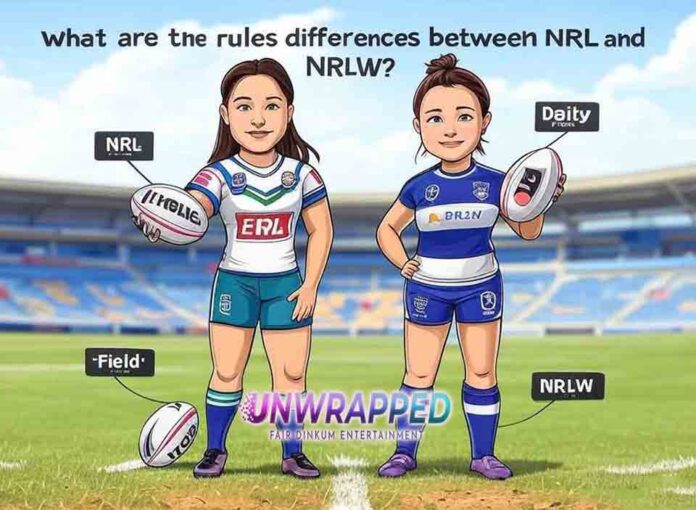The National Rugby League (NRL) and National Rugby League Women’s (NRLW) competitions are two of the most exciting leagues in Australian rugby. While both showcase the grit, skill, and strategy of rugby league, there are a few key differences in rules and structure tailored to the unique aspects of the men’s and women’s games. Understanding these differences enhances the appreciation of both leagues, offering fans and players alike a deeper connection to the sport.
Introduction to NRL and NRLW
The NRL has been a cornerstone of Australian rugby league for decades, featuring elite male athletes competing in a fast-paced, physically demanding environment. The NRLW, launched in 2018, has grown rapidly, providing a platform for female athletes to showcase their talent at the highest level. While the core essence of rugby league remains the same in both leagues, certain rule adjustments make the NRLW more accessible and suited to its developmental stage.
Key Rule Differences Between NRL and NRLW
1. Match Duration
- NRL: Matches are played over 80 minutes, divided into two halves of 40 minutes each.
- NRLW: Matches are shorter, lasting 70 minutes, split into two halves of 35 minutes each. This adjustment considers player workloads, particularly as the league continues to expand.
2. Interchange Rules
- NRL: Teams are allowed a maximum of eight interchanges during a match.
- NRLW: Interchange allowances are capped at 10 per game, providing teams with more flexibility to manage player fatigue and injuries.
3. Tackle Restarts
The six-again rule, designed to speed up play by resetting the tackle count for certain infringements, applies to both leagues. However:
- NRL: The six-again rule is often applied strictly across all minor infractions within the ruck.
- NRLW: There is slightly more leniency to encourage game flow and ensure a balanced contest, particularly as newer players adjust to elite-level competition.
4. Squad Sizes
- NRL: Teams consist of 17 players (13 on the field and 4 interchange players).
- NRLW: Teams also field 13 players but may have slightly different squad management rules based on the tournament structure.
5. Field Dimensions
The field dimensions are identical for both leagues, adhering to the standard rugby league field size of 100 meters in length and 68 meters in width.
Differences in Season Structure
1. Season Length
- NRL: The season spans 25 rounds, followed by a finals series.
- NRLW: The season is shorter, traditionally consisting of 9-12 rounds as the league continues to expand.
2. Finals Format
Both leagues feature finals series, but the NRLW has a condensed format compared to the NRL’s comprehensive finals schedule. The NRLW grand final remains a marquee event, typically held alongside the NRL grand final.
3. State of Origin
- NRL: The State of Origin series consists of three matches, showcasing intense rivalries between New South Wales and Queensland.
- NRLW: The women’s State of Origin started as a single match but has since expanded to a two-game series, reflecting its growing popularity.
Player Development Pathways
One of the most significant differences lies in the development pathways:
- NRL: Players often progress through well-established systems, including junior leagues, reserve-grade competitions, and professional contracts.
- NRLW: The pathways are still evolving, with increased investment in grassroots programs, talent identification, and player welfare initiatives. This ensures that the NRLW continues to grow sustainably.
Strategies and Gameplay Adjustments
1. Pace of Play
NRLW matches often emphasize skill, strategy, and ball handling over sheer physicality, resulting in a slightly different pace compared to the NRL. This allows for more tactical plays and showcases the technical aspects of rugby league.
2. Kicking Game
The kicking game in the NRLW is evolving, with many teams leveraging tactical kicks to gain territory or create scoring opportunities. While the NRL features power-based kicking, the NRLW emphasizes precision and placement.
The Impact of These Differences
These differences are not about creating a disparity but rather tailoring the game to the players and the league’s developmental stage. They:
- Enhance Player Welfare: Adjustments like shorter match durations and expanded interchanges prioritize player safety and long-term performance.
- Promote Spectator Enjoyment: NRLW matches are designed to be fast-paced and engaging, attracting new fans to the sport.
- Foster Growth: The NRLW’s differences allow for gradual development while maintaining the sport’s integrity.
How the NRLW is Evolving
The NRLW has seen tremendous growth in recent years, with more teams, increased media coverage, and better support for players. Rule changes and adaptations will likely continue as the league matures, ensuring it remains competitive and exciting.
Why Both Leagues Are Worth Watching
The NRL and NRLW each bring unique strengths to the table:
- NRL: Showcases years of tradition, intense rivalries, and world-class athleticism.
- NRLW: Highlights emerging talent, skillful gameplay, and the rapid rise of women’s rugby league.
By understanding the rules and their differences, fans can appreciate the nuances of each league and the incredible athletes who make rugby league a global phenomenon.
Additional Resources
For further reading and updates, check out these links:
Call to Action
Are you ready to experience the excitement of both leagues? Whether it’s the intense clashes of the NRL or the rising stars of the NRLW, rugby league has something for everyone. Share your thoughts in the comments below or join the conversation on social media. Don’t forget to check the official websites for the latest match schedules and tickets!
See Also: How can I buy tickets for NRLW matches?










